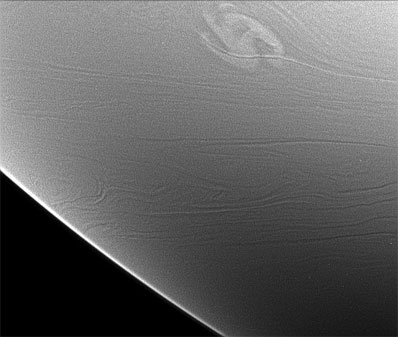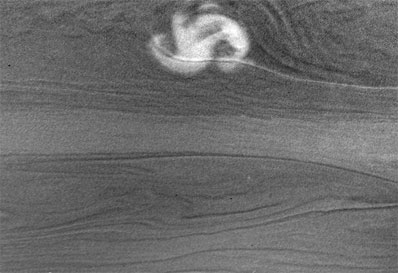
Spaceflight Now +

|

|

|

|

Premium video content for our Spaceflight Now Plus subscribers.

STS-3: Unique landing
 Columbia's STS-3 mission is best remembered in the history books for its conclusion -- the first and so far only landing at the picturesque Northrup Strip at White Sands, New Mexico. In this post-flight presentation film, the crew describes the highlights of the March 1982 mission and shows some of the fun they had in orbit. The commander also tells how he accidentally "popped a wheelie" before bringing the nose gear down to the runway surface. Columbia's STS-3 mission is best remembered in the history books for its conclusion -- the first and so far only landing at the picturesque Northrup Strip at White Sands, New Mexico. In this post-flight presentation film, the crew describes the highlights of the March 1982 mission and shows some of the fun they had in orbit. The commander also tells how he accidentally "popped a wheelie" before bringing the nose gear down to the runway surface.

 Small | Medium | Large Small | Medium | Large

STS-2: First reusable spaceship
 Seven months after the successful maiden voyage of space shuttle Columbia, astronauts Joe Engle and Richard Truly took the orbiter back into space on mission STS-2. The November 12, 1981 launch demonstrated that the space shuttle was the world's first reusable manned spacecraft. Although their mission would be cut short, Engle and Truly performed the first tests of the shuttle's Canadian-made robotic arm. The crew tells the story of the mission in this post-flight presentation. Seven months after the successful maiden voyage of space shuttle Columbia, astronauts Joe Engle and Richard Truly took the orbiter back into space on mission STS-2. The November 12, 1981 launch demonstrated that the space shuttle was the world's first reusable manned spacecraft. Although their mission would be cut short, Engle and Truly performed the first tests of the shuttle's Canadian-made robotic arm. The crew tells the story of the mission in this post-flight presentation.

 Small | Medium | Large Small | Medium | Large

STS-1: America's first space shuttle mission
 The space shuttle era was born on April 12, 1981 when astronauts John Young and Bob Crippen rode Columbia into Earth orbit from Kennedy Space Center's launch pad 39A. The two-day flight proved the shuttle could get into space as a rocket and return safely with a runway landing. Following the voyage of STS-1, the two astronauts narrated this film of the mission highlights and told some of their personal thoughts on the flight. The space shuttle era was born on April 12, 1981 when astronauts John Young and Bob Crippen rode Columbia into Earth orbit from Kennedy Space Center's launch pad 39A. The two-day flight proved the shuttle could get into space as a rocket and return safely with a runway landing. Following the voyage of STS-1, the two astronauts narrated this film of the mission highlights and told some of their personal thoughts on the flight.

 Small | Medium | Large Small | Medium | Large

NASA's 2007 budget
 NASA Administrator Mike Griffin, along with his science, spaceflight, exploration and aeronautics chiefs, hold this news conference in Washington on February 6 to discuss the agency's proposed budget for Fiscal Year 2007. The budget would give NASA a slight increase in funding over 2006, but it features cuts in some projects to pay for funding shortfalls in the shuttle program. NASA Administrator Mike Griffin, along with his science, spaceflight, exploration and aeronautics chiefs, hold this news conference in Washington on February 6 to discuss the agency's proposed budget for Fiscal Year 2007. The budget would give NASA a slight increase in funding over 2006, but it features cuts in some projects to pay for funding shortfalls in the shuttle program.

 Play video Play video

Suit tossed overboard
 The Expedition 12 crew tosses overboard an old Russian spacesuit loaded with ham radio gear during a spacewalk outside the International Space Station. The eery view of the lifeless suit tumbling into the darkness of space was captured by station cameras. The Expedition 12 crew tosses overboard an old Russian spacesuit loaded with ham radio gear during a spacewalk outside the International Space Station. The eery view of the lifeless suit tumbling into the darkness of space was captured by station cameras.

 Play video Play video

STS-95: John Glenn's return to space
 The flight of shuttle Discovery in October 1998 captured the public's attention with the triumphant return to space by John Glenn. The legendary astronaut became the first American to orbit the Earth some 36 years earlier. His 9-day shuttle mission focused on science experiments about aging. This post-flight presentation of highlights from the STS-95 mission is narrated by the astronauts. The flight of shuttle Discovery in October 1998 captured the public's attention with the triumphant return to space by John Glenn. The legendary astronaut became the first American to orbit the Earth some 36 years earlier. His 9-day shuttle mission focused on science experiments about aging. This post-flight presentation of highlights from the STS-95 mission is narrated by the astronauts.

 Small | Medium | Large Small | Medium | Large

Launch of New Horizons
 The New Horizons spacecraft begins a voyage across the solar system to explore Pluto and beyond with its successful launch January 19 aboard a Lockheed Martin Atlas 5 rocket from Cape Canaveral, Florida. The New Horizons spacecraft begins a voyage across the solar system to explore Pluto and beyond with its successful launch January 19 aboard a Lockheed Martin Atlas 5 rocket from Cape Canaveral, Florida.

 Full coverage Full coverage

 Become a subscriber Become a subscriber
 More video More video

|

|

|

|
|

|

Spacecraft spots powerful Saturn storm at night
CICLOPS NEWS RELEASE
Posted: February 14, 2006
Following the recent detection of Saturnian radio bursts by NASA's Cassini spacecraft that indicated a rare and powerful atmospheric storm, Cassini imaging scientists have spotted the storm in an unlikely fashion: they looked for it in the dark.

This image shows a rare and powerful storm on the night side of Saturn. Light from Saturn's rings (called "ringshine") provided the illumination, allowing the storm and other cloud features to be seen. Credit: NASA/JPL/Space Science Institute
Download larger image version here
|
When lightning-generated radio noise from the storm was detected by
Cassini on January 23, the spacecraft was at a place in its orbit where
it was unable to image the sunlit side of Saturn. Instead, imaging
scientists searched for the southern hemisphere storm in images of the
planet's night side. Fortunately, the small amount of sunlight
reflecting off Saturn's rings and illuminating the night side is enough
to make features in the atmosphere visible.
The storm is located on the side of Saturn that faces the spacecraft
when the radio emissions are detected; Cassini does not observe the
radio emissions for half a Saturnian day when the storm is on the
planet's other side.
The latitude of the new storm matches that of the "Dragon storm," which
was a powerful emitter of radio noise and was imaged by Cassini in 2004.
It lies in a region of the southern hemisphere referred to as "storm
alley" by scientists because of the high level of storm activity
observed there by Cassini. The storm's north-south dimension is about
3,500 kilometers (2,175 miles).
"It's really the only large storm on the whole planet," says Andrew
Ingersoll, a member of the Cassini imaging team. "It's in the right
place and it appeared at the right time to match the radio emissions, so
it has to be the right storm," he said.

The storm's north-south dimension is about 3,500 kilometers (2,175 miles); it is located at minus 36 degrees (planetocentric) latitude and 168 degrees west longitude. This places it on the side of the planet that faces the spacecraft when the radio emissions are detected; the radio emissions shut down for half a Saturnian day when the storm is on the other side. Credit: NASA/JPL/Space Science Institute
Download larger image version here
|
Cassini's investigation of the storm has also been aided by the efforts
of Earth-based amateur astronomers, who were able view Saturn's dayside
with their telescopes when Cassini could not. The amateurs' images of
Saturn provided the first visual confirmation of the storm, now revealed
in detail by the new views from Cassini.
The Cassini-Huygens mission is a cooperative project of NASA, the
European Space Agency and the Italian Space Agency. The Jet Propulsion
Laboratory (JPL), a division of the California Institute of Technology
in Pasadena, manages the Cassini-Huygens mission for NASA's Science
Mission Directorate, Washington. The Cassini orbiter and its two
onboard cameras were designed, developed and assembled at JPL. The
imaging team consists of scientists from the U.S., England, France, and
Germany. The imaging operations center and team leader (Dr. C. Porco)
are based at the Space Science Institute in Boulder, Colo.
|

|

|

|

|



